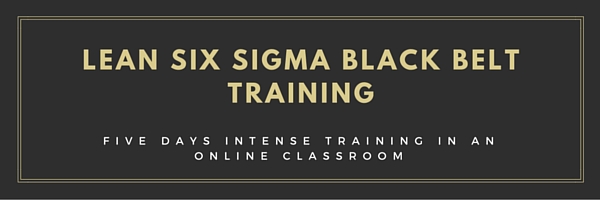Lean Six Sigma Black Belt Training
Five Days Intense Training in an Online Classroom
Click Here to register ($2099.00)
Dates : Aug 29-Sept 2 • Sept. 26-30 • Oct. 21-Nov 4
The fundamental objective of the Six Sigma methodology is the implementation of a measurement-based strategy that focuses on process improvement and variation reduction through the application of Six Sigma improvement projects. This is accomplished through the use of two Six Sigma sub-methodologies: DMAIC and DMADV.
The Six Sigma DMAIC process (define, measure, analyze, improve, control) is an improvement system for existing processes falling below specification and looking for incremental improvement. The Six Sigma DMADV process (define, measure, analyze, design, verify) is an improvement system used to develop new processes or products at Six Sigma quality levels. It can also be employed if a current process requires more than just incremental improvement. Both Six Sigma processes are executed by Six Sigma Green Belts and Six Sigma Black Belts, and are overseen by Six Sigma Master Black Belts.
Black Belts save companies approximately $230,000 per project and can complete four to 6 projects per year. GE first began Six Sigma in 1995 after Motorola and Allied Signal blazed the Six Sigma trail. Since then, thousands of companies around the world have discovered the far reaching benefits of Six Sigma.
Six Sigma Black Belt holders are in demand. See:
http://www.payscale.com/research/US/Certification=Certified_Six_Sigma_Black_Belt/Salary#by_State
On successful completion of course, participant will be able to:
- Understand Six Sigma & DMAIC Methodology
- Identify the voice of customers, their requirement & needs
- Understand their role in the success Deployment
- Understand how to develop a strategy for Six Sigma approach
- Apply the DMAIC process to Business issues.
Course Features:
- 1 copy of the book “Learn Six Sigma Black belt” course materials.
- 2 dozen tools & template files
- 40 Data sets matching every example throughout the course
- Roadmaps for DMAIC, Hypothesis testing and Control charts
- Downloadable pdf file of the entire course curriculum
- Custom certification letter with serial number and awarded CEU/PDUs
- Certification at no extra cost.
- Online and email support 24/7.
- IASSC accredited training organization, course ware aligned with IASSC and ASQ.
DAY 1: DEFINE PHASE
1.1 Six Sigma Overview
1.1.1 What is Six Sigma
1.1.2 Six Sigma History
1.1.3 Y = f(x) Approach
1.1.4 Six Sigma Methodology
1.1.5 Roles & Responsibilities
1.2 Fundamentals of Six Sigma
1.2.1 Defining a Process
1.2.2 VOC & CTQ’s
1.2.3 QFD
1.2.4 Cost of Poor Quality
1.2.5 Pareto (80:20 rule)
1.3 Lean Six Sigma Projects
1.3.1 Six Sigma Metrics
1.3.2 Business Case & Charter
1.3.3 Project Team Selection
1.3.4 Project Risk Management
1.3.5 Project Planning
1.4 Lean Fundamentals
1.4.1 Lean & Six Sigma
1.4.2 History of Lean
1.4.3 The Seven Deadly Muda
1.4.4 Five-S (5S)
DAY 2: MEASURE PHASE
2.1 Process Definition
2.1.1 Cause & Effect Diagrams
2.1.2 Cause & Effects Matrix
2.1.3 Process Mapping
2.1.4 FMEA
2.1.5 Theory of Constraints
2.2 Six Sigma Statistics
2.2.1 Basic Statistics
2.2.2 Descriptive Statistics
2.2.3 Distributions & Normality
2.2.4 Graphical Analysis
2.3 MSA
2.3.1 Precision & Accuracy
2.3.2 Bias, Linearity & Stability
2.3.3 Gage R&R
2.3.4 Variable & Attribute MSA
2.4 Process Capability
2.4.1 Capability Analysis
2.4.2 Concept of Stability
2.4.3 Attribute Capability
2.4.3 Discrete Capability
2.4.4 Monitoring Techniques
DAY 3: ANALYZE PHASE
3.1 Patterns of Variation
3.1.1 Multi-Vari Analysis
3.1.2 Classes of Distributions
3.2 Inferential Statistics
3.2.1 Understanding Inference
3.2.2 Sampling
3.2.3 Sample Size
3.2.4 Central Limit Theorem
3.3 Hypothesis Testing
3.3.1 Hypothesis Testing Goals
3.3.2 Statistical Significance
3.3.3 Risk; Alpha & Beta
3.3.4 Types of Hypothesis Test
DAY 3: ANALYZE PHASE (continued)
3.4 Hyp Tests: Normal Data
3.4.1 One and Two Sample t-tests
3.4.2 One Sample Variance
3.4.3 One Way ANOVA
3.5 Hyp Tests: Non-Normal
3.5.1 Mann-Whitney & Mood’s Median
3.5.2 Kruskal-Wallis
3.5.3 Moods Median
3.5.4 Friedman
3.5.5 1 Sample Sign
3.5.6 1 Sample Wilcoxon
3.5.7 1 and 2 Proportion
3.5.8 Chi-Squared
3.5.9 Test of Equal Variances
DAY 4: IMPROVE PHASE
4.1 Simple Linear Regression
4.1.1 Correlation
4.1.2 X-Y Diagram
4.1.3 Regression Equations
4.1.4 Residuals Analysis
4.2 Multiple Regression
4.2.1 Non-Linear Regression
4.2.2 Multiple Linear Regression
4.2.3 Confidence Intervals
4.2.4 Residuals Analysis
4.2.5 Box Cox Transformation
4.2.6 Stepwise Regression
4.2.7 Logistic Regression
4.3 Designed Experiments
4.3.1 Experiment Objectives
4.3.2 Experimental Methods
4.3.3 DOE Considerations
4.4 Full Factorial Experiments
4.4.1 2k Full Factorial Designs
4.4.2 Linear & Quadratic Models
4.4.3 Orthogonal Designs
4.4.4 Model & Center Points
4.5 Fractional Factorials4.5.1 Designs
4.5.2 Confounding Effects
4.5.3 Experimental Resolution
DAY 5: CONTROL PHASE
5.1 Lean Controls
5.1.1 Control Methods for 5S
5.1.2 Kanban
5.1.3 Poka-Yoke
5.2 SPC
5.2.1 Data Collection for SPC
5.2.2 I-MR Chart
5.2.3 Xbar-R Chart
5.2.4 U Chart
5.2.5 P Chart
5.2.6 NP Chart
5.2.7 X-S chart
5.2.8 CumSum Chart
5.2.9 EWMA Chart
5.2.10 Control Methods
5.2.11 Control Chart Anatomy
5.2.12 Variation & Sampling
5.2.13 Control Limits
5.3 Six Sigma Control Plans
5.3.1 Cost Benefit Analysis
5.3.2 Control Plan Elements
5.3.3 Response Plan
INSTRUCTORS
Click on the link for additional information about our instructors.
Tyrone Butler – CEMBB,CLSSMBB,TPS,ITIL,ITSM
